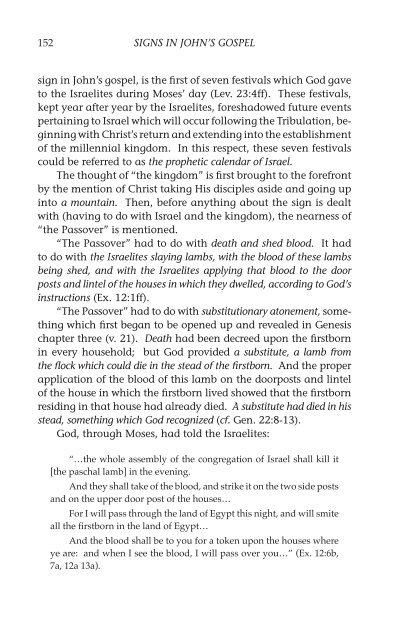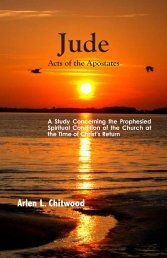Signs in John's Gospel - The Lamp Broadcast
Signs in John's Gospel - The Lamp Broadcast
Signs in John's Gospel - The Lamp Broadcast
You also want an ePaper? Increase the reach of your titles
YUMPU automatically turns print PDFs into web optimized ePapers that Google loves.
152 SIGNS IN JOHN’S GOSPEL<br />
sign <strong>in</strong> John’s gospel, is the first of seven festivals which God gave<br />
to the Israelites dur<strong>in</strong>g Moses’ day (Lev. 23:4ff). <strong>The</strong>se festivals,<br />
kept year after year by the Israelites, foreshadowed future events<br />
perta<strong>in</strong><strong>in</strong>g to Israel which will occur follow<strong>in</strong>g the Tribulation, beg<strong>in</strong>n<strong>in</strong>g<br />
with Christ’s return and extend<strong>in</strong>g <strong>in</strong>to the establishment<br />
of the millennial k<strong>in</strong>gdom. In this respect, these seven festivals<br />
could be referred to as the prophetic calendar of Israel.<br />
<strong>The</strong> thought of “the k<strong>in</strong>gdom” is first brought to the forefront<br />
by the mention of Christ tak<strong>in</strong>g His disciples aside and go<strong>in</strong>g up<br />
<strong>in</strong>to a mounta<strong>in</strong>. <strong>The</strong>n, before anyth<strong>in</strong>g about the sign is dealt<br />
with (hav<strong>in</strong>g to do with Israel and the k<strong>in</strong>gdom), the nearness of<br />
“the Passover” is mentioned.<br />
“<strong>The</strong> Passover” had to do with death and shed blood. It had<br />
to do with the Israelites slay<strong>in</strong>g lambs, with the blood of these lambs<br />
be<strong>in</strong>g shed, and with the Israelites apply<strong>in</strong>g that blood to the door<br />
posts and l<strong>in</strong>tel of the houses <strong>in</strong> which they dwelled, accord<strong>in</strong>g to God’s<br />
<strong>in</strong>structions (Ex. 12:1ff).<br />
“<strong>The</strong> Passover” had to do with substitutionary atonement, someth<strong>in</strong>g<br />
which first began to be opened up and revealed <strong>in</strong> Genesis<br />
chapter three (v. 21). Death had been decreed upon the firstborn<br />
<strong>in</strong> every household; but God provided a substitute, a lamb from<br />
the flock which could die <strong>in</strong> the stead of the firstborn. And the proper<br />
application of the blood of this lamb on the doorposts and l<strong>in</strong>tel<br />
of the house <strong>in</strong> which the firstborn lived showed that the firstborn<br />
resid<strong>in</strong>g <strong>in</strong> that house had already died. A substitute had died <strong>in</strong> his<br />
stead, someth<strong>in</strong>g which God recognized (cf. Gen. 22:8-13).<br />
God, through Moses, had told the Israelites:<br />
“…the whole assembly of the congregation of Israel shall kill it<br />
[the paschal lamb] <strong>in</strong> the even<strong>in</strong>g.<br />
And they shall take of the blood, and strike it on the two side posts<br />
and on the upper door post of the houses…<br />
For I will pass through the land of Egypt this night, and will smite<br />
all the firstborn <strong>in</strong> the land of Egypt…<br />
And the blood shall be to you for a token upon the houses where<br />
ye are: and when I see the blood, I will pass over you…” (Ex. 12:6b,<br />
7a, 12a 13a).



